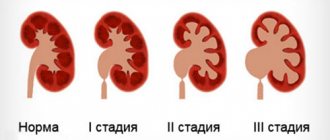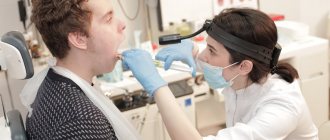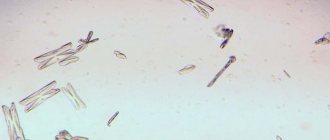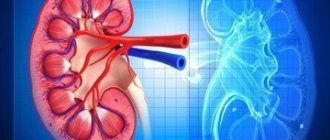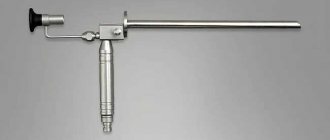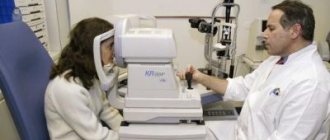From this article you will learn:
- What is pyelonephritis
- What are the causes of pyelonephritis in older people
- What are the symptoms of pyelonephritis
- How is pyelonephritis diagnosed in older people?
- What are the treatments for pyelonephritis in the elderly?
- What measures are there to prevent pyelonephritis in older people?
Pyelonephritis is a nonspecific inflammatory kidney disease that affects the renal parenchyma (mostly its interstitial part), as well as the renal pelvis and calyces. Pyelonephritis in older people ranks first among kidney diseases. Statistics indicate an annual incidence of pyelonephritis of about 0.1% of patients. Pyelonephritis can be unilateral or bilateral, primary or secondary, latent or recurrent. Let's look at the main reasons why it occurs, symptoms, treatment methods and methods of prevention.
What causes pyelonephritis in older people
Upon reaching 45–50 years of age, renal plasma flow, glomerular filtration, tubular secretion, and osmotic concentration of urine begin to slow down.
At the same time, there is a decrease in the blood supply to the nephrons and the functional capacity of their cells. This is due to sclerotic changes in the vessels and gradual involution of the glomeruli. Men are more susceptible to pyelonephritis than women, especially in the age group after 80 years. The reason for this is a progressive decrease in the activity of the prostate gland, a decrease in the protection of the urinary tract, including due to a decrease in the secretion of spermine, lysozyme and the thermostability of low molecular weight anti-infective factor. At the same time, the number of hypertrophic and tumor processes in the prostate increases, which also disrupt urodynamics. Of all inpatients in nephrology clinics, about 45% of men and 40% of women are people aged 80–90 years who suffer from pyelonephritis. The reasons contributing to the development of pyelonephritis include the following: 1. Elongated and tortuous ureters (often due to nephroptosis), decreased smooth muscle tone, slowing down the movement of urine through the urinary tract. 2. Reduced general and local immunity. 3. Existing refluxes at various levels of the urinary system. 4. Sclerotic processes in the kidneys. 5. Circumstances that increase the risk of urinary tract infections. These include:
- long bed rest;
- fecal and urinary incontinence;
- conducting research or assisting in emptying the bladder using a catheter.
6. Diseases leading to urodynamic disorders:
- benign prostatic hyperplasia;
- compression of the urinary tract with feces due to constipation;
- dehydration (with insufficient fluid intake, vomiting, diarrhea);
- tumors of the abdominal cavity and pelvis.
7. Diseases in which the composition of urine changes:
- multiple myeloma;
- progressive osteoporosis;
- urolithiasis disease;
- diabetes;
- gout;
8. Taking certain medications (for example, analgesics).
Read material on the topic: Diseases of the elderly
Secondary acute pyelonephritis
Secondary pyelonephritis is characterized by more pronounced symptoms, which are mainly caused by a violation of the process of excretion of urine from the body. This disease usually develops against the background of urolithiasis, prostate adenoma, and urinary tract pathologies.
If the disease was caused by kidney stones, then it is accompanied by renal colic - an attack of pain in the lower back. Then the patient’s well-being gradually worsens: general weakness occurs, thirst, tachycardia, and headache appear.
Separately, it is worth mentioning the symptoms of purulent forms of pathology, which usually arise in the process of complications of secondary pyelonephritis. Clinical manifestations of serous and purulent pyelonephritis are lower back pain, excessive tension of the abdominal muscles, fever, chills, delirium and confusion.
Clinical manifestations and diagnosis of pyelonephritis in elderly people
Symptoms of chronic pyelonephritis in older people are quite numerous and varied and can often resemble the clinical picture of other diseases.
The manifestations of the disease directly depend on its type. Experts talk about five forms of chronic pyelonephritis in older people.
- In the latent form, the disease occurs with mild symptoms; the patient may complain of weakness, fatigue, a slight increase in body temperature, headache, and minor pain in the lumbar region. Rarely, a positive Pasternatsky symptom, a slight increase in blood pressure, and the development of polyuria may be observed.
- In the hypertensive form, arterial hypertension is observed. In this case, the patient may complain of severe headache, dizziness, sleep disturbance, stabbing pain in the heart area, and shortness of breath.
- In the case of the anemic form, the symptoms of pyelonephritis are shortness of breath, weakness, fatigue, pallor of the skin, and pain in the heart.
- The azotemic form is indicated by pyelonephritis, which manifests itself in the development stage of chronic renal failure.
- Recurrent chronic pyelonephritis is characterized by remissions with frequent exacerbations. During the period of exacerbation, the clinical picture is similar to that observed in the acute form of the disease.
Even if the disease is asymptomatic, a person may notice causeless chills or nocturia (the predominance of nighttime diuresis over daytime).
Such symptoms are grounds for promptly contacting a urologist for timely diagnosis and treatment of pyelonephritis. In order to clarify the diagnosis, repeated urine tests are carried out (general analysis, bacteriological, studies according to Nechiporenko and Zimnitsky), ultrasound, excretory urography, renography, general and biochemical blood tests are taken, etc. Read material on the topic: Folk remedies for the elderly: healthy recipes
Diagnostics
The diagnosis of pyelonephritis is established on the basis of clinical manifestations and the results of examination of the patient, laboratory and instrumental studies.
Laboratory tests will make it possible to find out the severity of the pathological process, the type of causative agent of the disease, and whether the filtering ability of the kidneys is preserved.
General urine analysis
| Index | Norm | Pathology |
| Total white blood cell count | Up to 1-2 in sight | More than 2 in sight |
| Specific gravity | 1012-1025 units. | More than 1025 units. |
| Transparency | Transparent | Muddy |
| Bacteria | None | Present |
| Casts (casts of renal tubules) | None | Present |
Bacterial culture. It is carried out to identify the type of pathogen and its sensitivity to antibiotics.
Specific studies
Urine analysis according to the Nechiporenko method, analysis according to the Addis-Kakovsky method, Amburger test, analysis according to Zimnitsky (study of the concentrating ability of the kidneys). They are sometimes prescribed to clarify the quantitative and qualitative parameters of urine.
| Index | Norm | Pathology |
| Number of leukocytes and cylinders in 1 ml of urine (according to Nechiporenko) | White blood cells: <2000 Cylinders: < 20 | Exceeding the limit |
| Number of leukocytes and cylinders excreted in urine in 1 minute (according to Amburge) | White blood cells: <2000 Cylinders: < 20 | |
| Number of leukocytes and casts excreted in the urine in 1 day (according to Addis-Kakovsky) | White blood cells: <2 million. Cylinders: < 20000 | |
| Urine density (according to Zimnitsky) | Same throughout the day | Daytime urine is denser than nighttime urine |
General blood analysis
| Index | Norm | Pathology |
| Total number of leukocytes (per liter) | Adults: 5-9 x 109 Children: 7-11 x 109 | Exceeding the limit |
| Number of young forms of leukocytes | 2-6% | |
| Erythrocyte sedimentation rate, mm/hour | Men: 1-10 Women: 2-15 |
Blood chemistry
| Index | Norm | Pathology |
| Creatinine, µmol per liter | Men: 62-124 Women: 42-97 | Exceeding the limit |
| Urea, mmol per liter | 2,5-8,3 | |
| Potassium, mmol per liter | 3,35–5,35 |
Instrumental methods for diagnosing pyelonephritis include:
- Ultrasound of the kidneys - to assess structural changes in the kidney tissue;
- excretory urography - to determine the functional and morphological state of the kidneys, pelvis and ureters;
- dynamic scintigraphy - to assess the passage of urine from the kidneys through the ureters to the bladder;
- CT and MRI - allow you to get a more detailed picture. They are prescribed only according to a doctor’s indications, to differentiate infectious inflammation from a tumor process.
Kidney biopsy is of little value for diagnosis due to the focal nature of the lesion.
Features of treatment of pyelonephritis in the elderly
A feature of pyelonephritis in older people is its severe and atypical course, characterized by frequent purulent complications (even if the body temperature is not very elevated and there is no leukocytosis), which is very noticeable when using antibacterial therapy.
Only half of elderly and senile patients suffer from pyelonephritis, which occurs with a typical clinical picture, while laboratory data immediately shows the existing inflammatory process and its localization. The most serious complications of pyelonephritis in older people include urosepsis and bacteriotoxic shock; these complications most often occur in people over 60 years of age. Research shows that purulent forms of pyelonephritis occur in 23.3% of elderly men and 15.9% of elderly women. Most often, purulent forms of the disease occur in the seventh and eighth decades of life. Moreover, in men, pyelonephritis is combined with tumors of the urinary system and urolithiasis, while in women - with urolithiasis and diabetes mellitus.
To achieve the best result of antibacterial therapy, one should proceed from the sensitivity of the infectious agent. However, most often treatment begins with the prescription of broad-spectrum antibacterial agents: co-trimoxazole, amoxicillin, cefuroxime, fluoroquinolones (ofloxacin, ciprofloxacin), oxacillin and gentamicin (with caution). Elderly and senile patients should not be prescribed aminoglycosides, lolymyxins, amphotericin B. In addition, it must be taken into account that the dosage of drugs for such patients should be 30–50% lower than the average therapeutic level.
- Recommended articles to read:
- Social services for older people
- Diseases of old age
- Valuable tips on how to choose a boarding house
After stopping the disease, older people need long-term (from six months to a year) maintenance therapy. During this time, 10–14-day courses of treatment with antibacterial drugs are carried out every month: nitrofurans (furazolidone, furadonin), nitroxaline, biseptol, urosulfan. Next, herbal medicine is used with diuretic medicinal plants (such as lingonberry leaves, strawberry leaves and flowers, parsley grass and root, horsetail, chamomile), as well as plants with a bactericidal effect (birch leaves and buds, plantain leaves, linden flowers, calendula, leaves eucalyptus, lingonberry, cranberry). If the patient suffers from arterial hypertension, diuretics, beta blockers, calcium antagonists, and ACE inhibitors are prescribed.
For concomitant anemia, iron-containing preparations are used simultaneously with ascorbic acid.
In addition, elderly and senile people are prescribed multivitamins, pentoxyl, methyluracil, etc. as maintenance therapy for pyelonephritis. Care for elderly patients includes mandatory adherence to the prescribed diet, regular (1-2 times a week) measurement of water balance, frequent monitoring of the state of hemodynamic parameters and body temperature. Helping patients with hygiene procedures, preparation for instrumental examinations, and urine collection is of great importance. Particular attention should be paid to elderly and senile people who are on bed rest, have mental disorders, and are at high risk of developing acute vascular insufficiency. Pyelonephritis in older people is treated comprehensively, including by following a diet, bed rest, and taking medications. An exacerbation of the disease requires immediate hospitalization, strict adherence to first bed rest, then semi-bed rest, and antibacterial therapy. The selection of a diet is carried out taking into account the severity of renal failure - this can be a regular diet for older people with limited salt intake, or it can be dietary table No. 7, in which protein foods are limited.
The diet must necessarily include fruits and vegetables with a high potassium content, boiled lean meat, eggs, and dairy products. The amount of fluid consumed should be from 1.5 to 2 liters daily (during an exacerbation of the disease, the amount of fluid is limited). The hypertensive form of pyelonephritis requires reducing the amount of salt in the diet.
Phytotherapy
To treat pyelonephritis in older people, you can use folk remedies in the form of infusions and decoctions of medicinal plants. A positive result can be achieved by consuming:
- leaves of strawberry, lingonberry, eucalyptus, birch, plantain;
- greens and parsley root;
- linden flowers, chamomile, calendula;
- cranberries and lingonberries;
- horsetail grass.
However, herbal medicine can be used only after consultation with your doctor and only as an addition to complex treatment. Taking any medications on your own without a doctor’s recommendation is strictly prohibited!
Surgery
Very rarely, but there are cases when it is necessary to remove a kidney (nephrectomy) to treat chronic pyelonephritis. Indications for surgical treatment are:
- unilateral pyelonephritis, not amenable to conservative therapy;
- renal shrinkage complicated by severe hypertension.
Any form of clinical pyelonephritis in older people is treated on the basis of medical prescriptions; self-medication for such a disease is unacceptable and life-threatening.
Only following all the recommendations of the attending physician will avoid serious consequences. Read material on the topic: Bronchitis in the elderly





